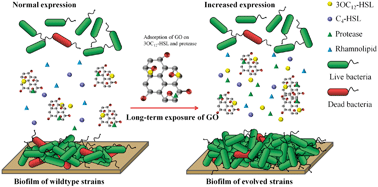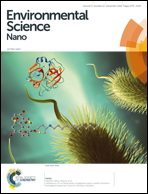Interference of non-lethal levels of graphene oxide in biofilm formation and adaptive response of quorum sensing in bacteria
Abstract
With the increasing use of graphene oxide (GO) in products and processes, its ecological safety has been raised as an urgent concern. Although the toxicity of GO has been widely investigated, research concerning the effects of non-lethal levels of GO on biofilm formation and quorum sensing (QS) is limited. Here, Pseudomonas aeruginosa PAO1 was employed to evaluate the effects of non-lethal levels of GO on these bacterial social behaviors. After short-term exposure, GO levels below 40 mg L−1 did not affect population propagation but did interfere with biofilm formation. Although GO did not change the transcription of QS-related genes, it adsorbed the QS signals N-3-oxo-dodecanoyl homoserine lactone (3OC12-HSL) and QS-regulated proteases. Adsorption of 3OC12-HSL was one of the main mechanisms by which GO interfered with biofilm formation. During long-term treatment, the amount of 3OC12-HSL and proteases in the culture increased gradually. The GO-mediated inhibition of biofilm formation was reduced after about 160 generations of propagation due to an adaptive response of the QS to GO exposure. We conclude that the short-term effects of GO exposure are not sustained because of bacterial adaptation to GO adsorption. In this regard, there is no adverse ecological impact from GO treatment under non-lethal levels.



 Please wait while we load your content...
Please wait while we load your content...